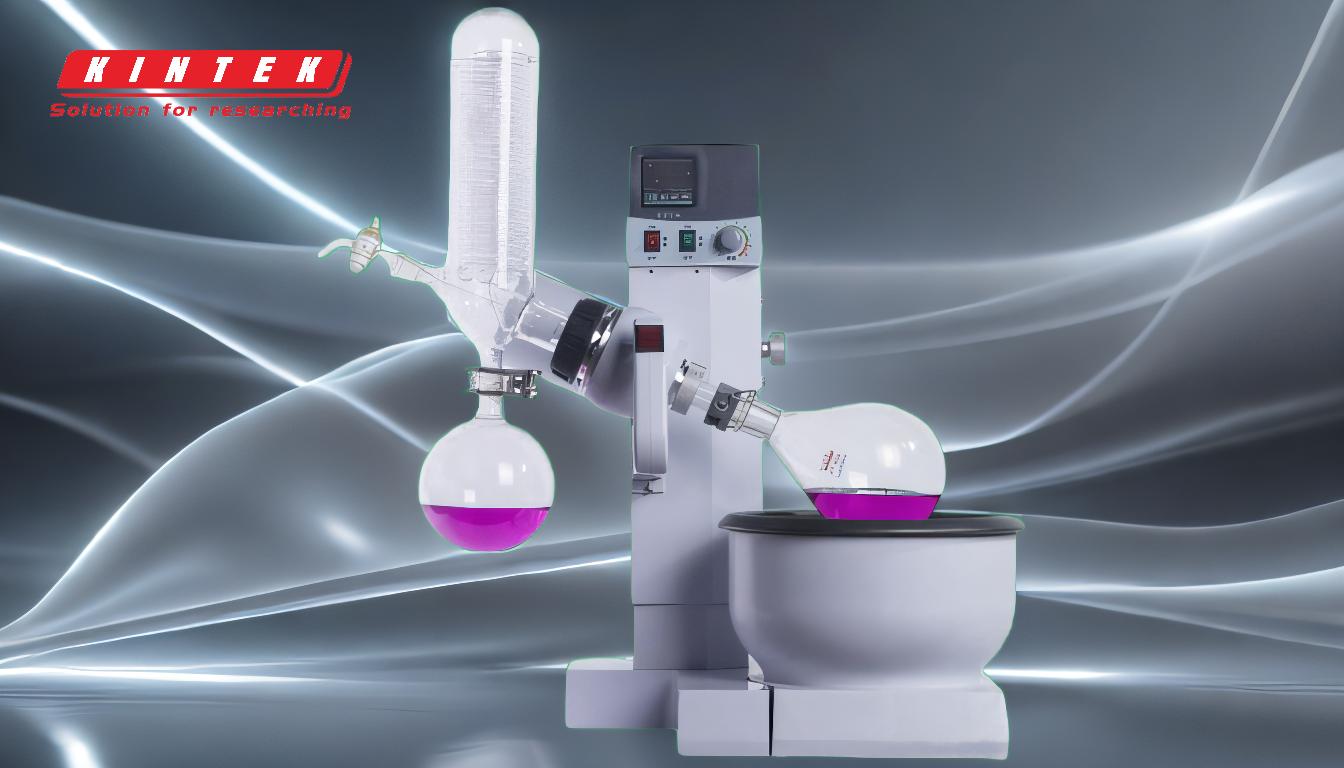The rotary evaporator extraction procedure is a precise and efficient method used to separate and concentrate compounds, particularly in plant extraction processes like cannabis. The process involves reducing the pressure in the system to lower the solvent's boiling point, rotating the flask to increase surface area, and evaporating the solvent at controlled temperatures. The evaporated solvent is then condensed and collected, leaving behind a concentrated extract. This method is highly effective for preserving desirable compounds like cannabinoids, flavonoids, and terpenes while removing unwanted lipids and waxes. Below is a detailed breakdown of the procedure and its key steps.
Key Points Explained:

-
Purpose and Application of Rotary Evaporator Extraction
- The rotary evaporator is primarily used for plant extraction, especially in cannabis processing, to isolate desirable compounds such as cannabinoids, flavonoids, and terpenes.
- It is effective in producing concentrated products like shatter and THCA, which are used in oral formulations.
- The process also removes lipids and waxes, ensuring a purer final product.
-
Key Steps in the Rotary Evaporator Extraction Process
-
Step 1: Extraction of Desirable Compounds
- The raw plant material is processed to extract the desired compounds using a solvent like ethanol.
-
Step 2: Winterization
- The extract is winterized to remove fats, lipids, and waxes by cooling the solution and filtering out the solidified impurities.
-
Step 3: Distillation
- The winterized concentrate is distilled using the rotary evaporator to remove the solvent (ethanol) and further concentrate the desired compounds.
-
Step 1: Extraction of Desirable Compounds
-
Detailed Rotary Evaporator Setup and Operation
-
Preparation:
- Fill the distilling flask to no more than 50% of its volume to prevent spillage during rotation.
- Set the water bath temperature to 30-40°C, which is optimal for solvent evaporation without degrading heat-sensitive compounds.
- Set the condenser temperature to -10°C to 0°C to ensure efficient condensation of the evaporated solvent.
-
Rotation and Vacuum Application:
- Start rotating the flask at 150-200 rpm to create a thin film of the solution, increasing the surface area for evaporation.
- Gradually apply a vacuum using a vacuum pump to lower the solvent's boiling point, allowing evaporation at lower temperatures.
-
Evaporation and Condensation:
- As the solvent evaporates, it condenses on the cooled condenser surface and collects in the distillate flask.
- Continue the process until all the solvent is removed, leaving behind a concentrated extract.
-
Preparation:
-
Operational Considerations
-
Rotation Speed:
- Adjust the rotation speed based on the volume of the solution to ensure optimal film formation and evaporation.
-
Vacuum Control:
- Gradually increase the vacuum to avoid sudden boiling or foaming, which can lead to sample loss.
-
Temperature Management:
- Maintain the water bath and condenser temperatures within the specified ranges to ensure efficient evaporation and condensation without degrading the compounds.
-
Rotation Speed:
-
Advantages of Rotary Evaporator Extraction
-
Preservation of Compounds:
- The low-temperature evaporation process preserves heat-sensitive compounds like cannabinoids, flavonoids, and terpenes.
-
Efficiency:
- The thin film created by rotation and the reduced pressure significantly enhance solvent evaporation rates.
-
Purity:
- The process effectively removes unwanted lipids and waxes, resulting in a cleaner and more concentrated final product.
-
Preservation of Compounds:
-
Applications Beyond Cannabis Extraction
- While the procedure is highly effective for cannabis extraction, it is also widely used in other industries, such as pharmaceuticals, food processing, and essential oil extraction, for separating and concentrating compounds.
-
Safety and Maintenance Tips
-
Safety Precautions:
- Always wear appropriate personal protective equipment (PPE) when handling solvents and operating the rotary evaporator.
- Ensure proper ventilation in the workspace to avoid inhaling solvent vapors.
-
Maintenance:
- Regularly clean the rotary evaporator components to prevent contamination and ensure optimal performance.
- Check the vacuum pump and condenser for proper functioning before each use.
-
Safety Precautions:
By following this structured procedure, the rotary evaporator extraction process can be effectively utilized to produce high-quality, concentrated extracts while preserving the integrity of the desired compounds. This method is particularly valuable in industries requiring precise and efficient separation techniques.
Summary Table:
| Key Steps | Details |
|---|---|
| Extraction of Compounds | Use solvents like ethanol to extract cannabinoids, flavonoids, and terpenes. |
| Winterization | Remove fats, lipids, and waxes by cooling and filtering the solution. |
| Distillation | Use a rotary evaporator to remove solvents and concentrate desired compounds. |
| Rotation Speed | 150-200 rpm for optimal film formation and evaporation. |
| Temperature Control | Water bath: 30-40°C; Condenser: -10°C to 0°C for efficient condensation. |
| Vacuum Control | Gradual vacuum application to prevent boiling or foaming. |
Ready to optimize your extraction process? Contact our experts today for tailored solutions!











